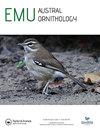Physiological validation of the use of faecal glucocorticoid metabolites as a measure of stress in a passerine and a columbid from southern Africa
IF 1.1
4区 生物学
Q3 ORNITHOLOGY
引用次数: 0
Abstract
ABSTRACT Faecal glucocorticoid metabolite (fGCM) analysis provides a non-invasive, feedback-free approach for monitoring adrenocortical responses to natural and anthropogenic stressors. The use of enzyme-immunoassays (EIAs) to quantify immunoreactive fGCMs has gained popularity in recent years but requires species-specific validation prior to first use. We conducted a pharmacological challenge with adrenocorticotropic hormone (ACTH) to determine whether changes in circulating glucocorticoids are reflected in fGCM, concentrations and therefore to validate excreta as a matrix for monitoring endocrine status in a southern African passerine, the White-browed Sparrow-weaver (Plocepasser mahali) and a columbid, the Laughing Dove (Spilopelia capensis). We tested the suitability of four EIAs to quantify fGCMs in 10 individuals of each species. Two of the EIAs, tetrahydrocorticosterone and 11-Oxoetiocholanolone II, detected significant elevations and were therefore most suitable for quantifying fGCMs in the White-browed Sparrow-weavers. In contrast, the 5α-pregnane-3β, 11β, 21-triol-20-one EIA detected the highest elevations in fGCM concentrations in the Laughing Doves. The lag time between stressor initiation (ACTH injection) and the resulting peak fGCM concentrations was ~2 h in both species. The validations presented here open opportunities for monitoring physiological responses in free-ranging individuals and contribute to our knowledge of the EIAs suitable for non-invasive quantification of avian fGCM concentrations.使用粪便糖皮质激素代谢物作为非洲南部雀形目动物和哥伦比亚虫的应激测量的生理验证
粪便糖皮质激素代谢物(fGCM)分析为监测肾上腺皮质对自然和人为应激源的反应提供了一种无创、无反馈的方法。近年来,使用酶免疫测定法(EIAs)来量化免疫反应性fgcm越来越受欢迎,但在首次使用之前需要进行物种特异性验证。我们对促肾上腺皮质激素(ACTH)进行了药理学挑战,以确定循环糖皮质激素的变化是否反映在fGCM浓度中,从而验证排泄物作为监测非洲南部雀鸟白眉编织麻雀(Plocepasser mahali)和柱头目笑鸽(Spilopelia capensis)内分泌状态的基质。我们在每个物种的10个个体中测试了4个eia的适用性,以量化fgcm。四氢皮质酮和11-氧etiocholanolone II这两种eia检测到显著升高,因此最适合用于量化白眉织造麻雀的fgcm。5α-孕酮-3β, 11β, 21-三醇-20- 1 EIA检测到笑鸽中fGCM浓度的最高升高。应激源启动(注射ACTH)与产生的fGCM峰值浓度之间的滞后时间在两种物种中均为~2 h。本文提出的验证为监测自由放养个体的生理反应提供了机会,并有助于我们了解适合禽类fGCM浓度非侵入性定量的环境影响评估。
本文章由计算机程序翻译,如有差异,请以英文原文为准。
求助全文
约1分钟内获得全文
求助全文
来源期刊

Emu-Austral Ornithology
生物-鸟类学
CiteScore
2.00
自引率
7.70%
发文量
33
审稿时长
>12 weeks
期刊介绍:
Emu – Austral Ornithology is the premier journal for ornithological research and reviews related to the Southern Hemisphere and adjacent tropics. The journal has a long and proud tradition of publishing articles on many aspects of the biology of birds, particularly their conservation and management.
 求助内容:
求助内容: 应助结果提醒方式:
应助结果提醒方式:


